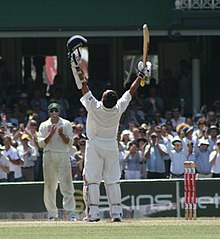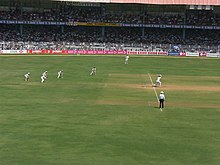History of the Indian cricket team
This article needs additional citations for verification. (December 2020) |
The Indian cricket team made its
Cricket was introduced to the Indian subcontinent by European merchant sailors in the 18th century, and the first cricket club was established in 1792. India's national cricket team did not play its first Test match until 25 June 1932 at Lord's, becoming the sixth team to be granted Test cricket status. From 1932 India had to wait until 1952, almost 20 years for its first Test victory. In its first fifty years of international cricket, India was one of the weaker teams, winning only 35 of the first 196 Test matches it played. The team, however, gained strength in the 1970s with the emergence of players such as Gavaskar, Viswanath, Kapil Dev, and the Indian spin quartet.
India won its first
, considered to be among the greatest Indian players.History

Test status (1932–1970)
A few Indians played as members of the
The team's first series as an independent country was in 1948 against
India's first ever Test victory came against England at
The team's performances again began to improve in the 1960s, starting with their first series win over England in 1961–62. During this time, India's strong record at home started to develop, in which the team won a series against New Zealand in 1965-66 and drew series against Pakistan, Australia and England. In 1967–68, India won their first series outside the
One-day cricket and World Cup success (1970–1985)
During the 1980s, other players like
Late 20th century (1985–2000)
In 1985, India won the World Championship of Cricket in Australia. The Test series victory in 1986 in England remained, for nearly 19 years, the last Test series win outside subcontinent. Sunil Gavaskar became the first batsman to accumulate 10,000 runs in Test cricket, and went on to register a record 34 centuries, surpassed only recently by Sachin Tendulkar. Kapil Dev, a genuine all-rounder, became the highest wicket taker in Test cricket, surpassing Richard Hadlee to take a total of 434 wickets, a record which has since been broken by Courtney Walsh, Shane Warne and Muttiah Muralitharan and has also been surpassed by fellow Indian Anil Kumble. The emergence of Sachin Tendulkar and
Towards the end of 1999, the Indian team was in flux. Although they had performed well in the 1999 World Cup, the winter was marked by a disastrous tour to Australia which exposed the Indian team's weaknesses when playing abroad, marked with a loss of form of most of the batsmen, except Tendulkar and the newly emerged VVS Laxman. After Tendulkar quit captaincy and Azharuddin was banned for match-fixing, Sourav Ganguly took over as captain, and the New Zealander John Wright became coach.
Turn of the millennium (2000–2007)
This section needs additional citations for verification. (December 2020) |

- SuperTest" against Australia.[12]
In 2005, Indian cricket was again shrouded in controversy. After a somewhat slow season marked by a dip in team performance following the famous Pakistan series ended, the coaching job passed from John Wright to the Australian Greg Chappell. Saurav Ganguly, whose batting form had taken a beating in that year, was involved in a spat with Chappell over whether he should be continuing as captain to reduce pressure on him. This was followed by Ganguly being dropped from the team and Rahul Dravid taking over as captain. While Tendulkar, Sehwag and Dravid formed the mainstay of the Indian batting, the coming of age of players like Yuvraj Singh and Mohammad Kaif led to the emergence of younger stars like Suresh Raina and MS Dhoni.
India's traditional strengths have always been its line-up of
India has had a very good record against Australia and, before the 2004/05 tour, never being defeated by Australia in a Test Series in India since 1969. This was the reason for
Since 2004, India had not been doing as well in One-day Internationals. The players who took India to great heights over the past ten years such as Sachin Tendulkar, Sourav Ganguly and Anil Kumble grew older and did not maintain their form and fitness. Following the series loss to Australia, India collapsed on the final day in the Third Test in
The tension resulted in a fallout between Chappell and Ganguly lead to a confidential email sent by Chappell to the BCCI being leaked, in which he condemned the leadership and performance of Ganguly. After a series of high-profile board meetings and public jousting including some players,
Dravid's captaincy was cut short in the ill-fated 2007 World Cup, where India were out of the league stage following an embarrassing loss to Bangladesh. This was followed by Mahendra Singh Dhoni taking over the reins.
Under Dhoni, Kohli and Rohit (2007–present), Dhoni (2007-2017), Kohli (2014-2022), Rohit (2021-Present).

Under MS Dhoni, India won the inaugural T20 World cup.[17] It also began an era of India's dominance in world cricket in both tests and ODIs, culminating in a victory in the 2011 Cricket World Cup and a 4–0 whitewash of Australia in a home test series.[18] It also saw Indian batsmen scoring the only 200s ever, first Sachin Tendulkar then Virender Sehwag and then Rohit Sharma on three occasions.[19]
Dhoni has been widely acknowledged as the most successful Indian captain ever.[20] However, following a drubbing in a test series down under in late 2014, he retired from tests.[21]

In the 2015 World Cup, India reached the semi-finals.[22]
In June 2017,
In January 2018, Virat Kohli led Indian team toured South Africa where they lost the Test series by 1–2.[25] But the Team showed some extravagant skills and defeated the mighty South African team and clinched the ODI series by 5–1[26] and T20I series by 2–1.[27] By the series win, India became the second Asian country to defeat South Africa in ODI and T20I series on their home soil after Pakistan.
In the 2019 World Cup, India were defeated in the semi-finals by New Zealand.[28]
A new era began when the captaincy was passed from Virat Kohli to Rohit Sharma and coaching shifted from Ravi Shastri to Rahul Dravid. Rohit has won various trophies as a captain when Virat was rested as The Asia Cup, Nidahas Trophy and won series against Sri Lanka, New Zealand. Under Rahul Dravid's coaching men in blue whitewashed New Zealand when it was led by Rohit Sharma with 3–0 with Rohit himself scoring 48, 55, 56 in 3 matches being the highest scorer in the series.
International tournaments
Since advancing to full Test Status and the creation of more and more international cricket tournaments, India has slowly become involved in a number of Cricketing tournament's including the Cricket World Cup, ICC Champions Trophy and Asia Cup. India's first two Cricket World Cups were largely failures, and the team failed[29] to progress beyond the first round. But India upset the West Indies in the final of the 1983 Cricket World Cup to claim the Prudential Cricket World Cup for the first time, captained by Kapil Dev. India and the West Indies had cruised through the preliminary rounds in Group B, while England and Pakistan emerged the victors from Group A. Most considered India to be the underdogs in the group stages, and their win against West Indies was categorized as similar to Zimbabwe's win over Australia in the same World Cup. They were, in fact, quoted as having odds of 66 to 1 before the beginning of the tournament.

India's performance in the remaining world cups has been considerably consistent. In the 1987 Cricket World Cup, the team advanced to the semi-finals as favourites, they did the same in 1996, both times they suffered upset defeats in the semi-finals. India was less strong in the 1999 Cricket World Cup, and did not make it past the Super Six section. However they impressed all in the 2003 Cup, only losing two games (both against reigning champions Australia) and advancing to the finals before taking a loss.
In the year after their World Cup victory, (1984) India continued its new-found dominance over One Day Cricket with a comprehensive win over arch-rivals
References
- ^ ICC website: 2005 Archived 2 November 2008 at the Wayback Machine 2006 Archived 17 September 2008 at the Wayback Machine 2007 Archived 9 September 2008 at the Wayback Machine 2008 Archived 5 September 2008 at the Wayback Machine
- ISSN 0971-751X. Retrieved 22 October 2021.
- ^ Prasad, Dhruva (18 October 2021). "T20 World Cup 2007: India's moment of reckoning". Sportstar. Retrieved 22 October 2021.
- ISSN 0971-751X. Retrieved 22 October 2021.
- ISSN 0971-751X. Retrieved 22 October 2021.
- ^ "Sachin Tendulkar is greatest cricketer in history - Brian Lara". BBC Sport. 12 November 2013. Retrieved 13 February 2020.
- ^ Sheringham, Sam (2 April 2011). "India power to World Cup triumph". BBC. Retrieved 13 February 2020.
- ^ "India's team mentor Dhoni joins squad for T20 World Cup campaign". The Indian Express. 18 October 2021. Retrieved 22 October 2021.
- ISSN 0971-751X. Retrieved 22 October 2021.
- ISSN 0971-751X. Retrieved 23 October 2021.
- ISSN 0971-751X. Retrieved 23 October 2021.
- ^ "Full Scorecard of Australia vs ICC World XI Only Test 2005/06 - Score Report". ESPNcricinfo. Retrieved 23 October 2021.
- ^ "India - Test Career Bowling - Most Wickets". ESPNcricinfo. Retrieved 26 October 2006.
- ^ Waugh, Steve. "Steve Waugh Column". www.cricinfo.com/. Retrieved 21 September 2006.
- ^ "TWI gets production rights for India-Pakistan series". www.hinduonnet.com/. The Hindu - Sport. Archived from the original on 26 November 2007. Retrieved 14 October 2006.
{{cite web}}: CS1 maint: unfit URL (link) - ^ "India can find right balance before World Cup - Gavaskar". ESPNcricinfo. Retrieved 6 October 2021.
- ISSN 0971-751X. Retrieved 23 October 2021.
- ^ "Full Scorecard of Sri Lanka vs India Final 2010/11 - Score Report". ESPNcricinfo.
- ^ "Records. One-Day Internationals. Batting records. Most runs in an innings". ESPNcricinfo. Retrieved 23 October 2021.
- ISSN 0971-751X. Retrieved 23 October 2021.
- ISSN 0971-751X. Retrieved 23 October 2021.
- ^ "Full Scorecard of Australia vs India 2nd Semi-Final 2014/15 - Score Report". ESPNcricinfo. Retrieved 22 October 2021.
- ISSN 0971-751X. Retrieved 23 October 2021.
- ^ PTI. "Rahane: India's aim 'to remain No. 1 in Tests'". Sportstar. Retrieved 23 October 2021.
- ISSN 0971-751X. Retrieved 23 October 2021.
- ^ "India vs South Africa ODI series report card: Virat Kohli, wrist-spinners pass with flying colours; AB de Villiers flunks". Firstpost. 18 February 2018. Retrieved 23 October 2021.
- ^ "India vs South Africa 3rd T20I: India beat South Africa by seven runs to win series 2-1. Cricket News - Times of India". The Times of India. 25 February 2018. Retrieved 23 October 2021.
- ISSN 0971-751X. Retrieved 22 October 2021.
- ^ "Smriti Mandhana Says Indian Cricket Needs Six-Team Women's IPL - Betting Raja". 19 August 2021. Retrieved 18 December 2021.
